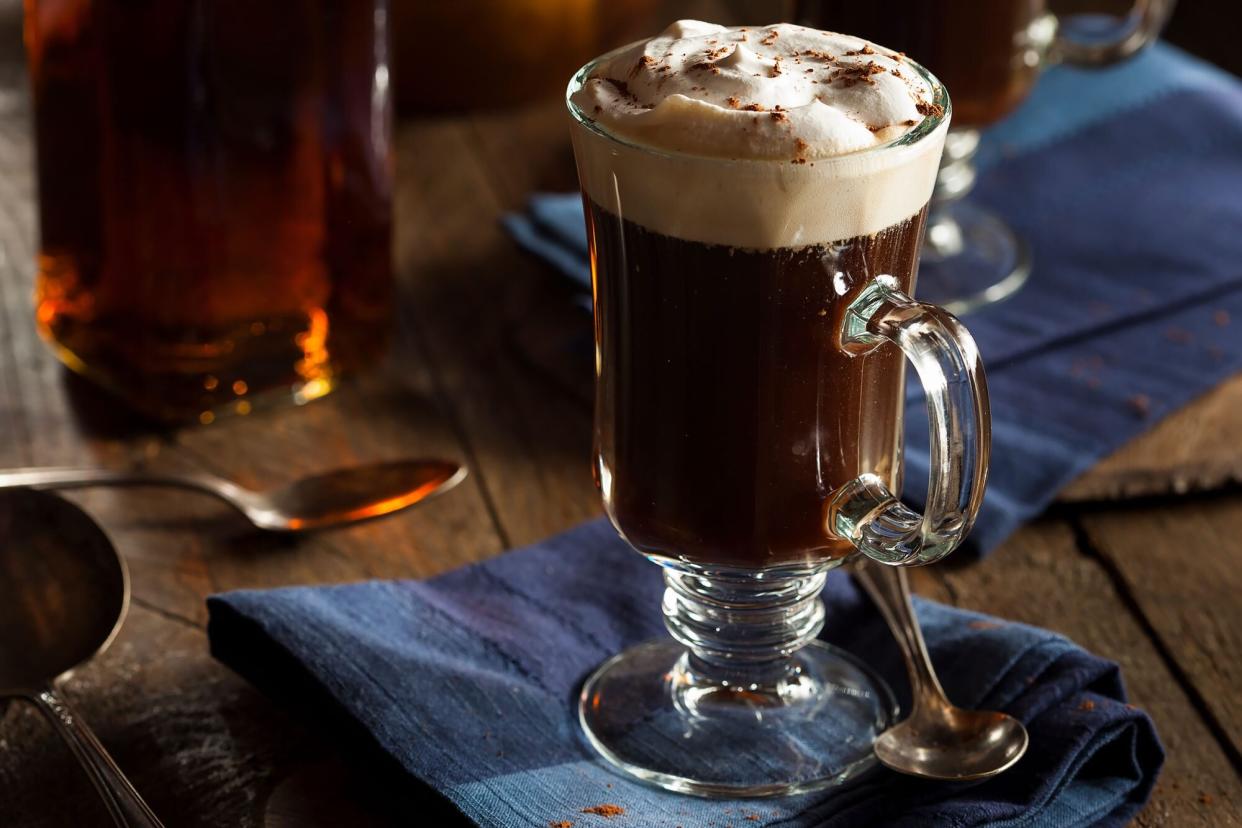The Irish Coffee Walked So the Espresso Martini Could Run

Brent Hofacker / Getty Images
Here's a challenge: Grab a seat at a bar at your favorite local restaurant haunt, or maybe some place that's known to have great cocktails. Let your eyes drift down the menu, taking in all of the options. How long before you spot an espresso martini? Maybe it has a fancy name wherever you're at, but if you see vodka, coffee, and some sort of liqueur, that's effectively what you're getting.
"[The espresso martini] is having a moment," says spirits educator Tiffanie Barriere. "It's been having a moment. It's part of a martini craze, and coffee will never be out of style."
After falling into relative obscurity after its debut in the 1980s, bars and restaurants across the country are giving the espresso martini coveted space on their cocktail menus for good reason. Celebrities have been snapped enjoying the cocktail at affluent bars, while TikTok stars have hopped on the bandwagon to walk their followers through how they make their version of the cocktail."When we reopened in early March 2022, the first six to nine months, we didn't have a single call for an espresso martini." says Jesse Cyr, beverage director at the Fairmont Olympic Hotel in Seattle, Wa. "Now it's every day we're making at least a handful. When it's really popping, like on Fridays and Saturday nights, we could get anywhere from 10 all the way up to 40 orders."
For context, the espresso martini was created in London in 1983 by legendary bartender Dick Bradsell, who came up with the now-famous recipe when a model sat at his bar and asked him to make her a drink that would both give her a jolt of energy and get her tipsy. Originally, Bradsell called his cocktail a vodka espresso, and made it by combining fresh espresso with sugar, a coffee liqueur and vodka. The concoction came just forty years after the Irish coffee cocktail was invented in 1943, at a small airport restaurant in Foynes, Ireland, when travelers bound for New York were grounded due to bad weather and marooned at the airport. Chef Joe Sheridan whipped up a steaming pot of coffee, added some local whiskey, sugar and a thick cream topper. The rest, as they say, is history.
Bearing in mind these timelines, one could easily argue that there would be no espresso martini without the original caffeinated boozy drink, the Irish coffee. Both the Irish coffee and espresso martini feature coffee in some form, a spirit — in the case of Irish coffee, Irish whiskey is used, while the espresso martini can be made with vodka, mezcal, rum or whiskey — and a sweetener. Both can also be enjoyed at any time during a meal but usually, in America at least, offered as an after dinner drink.
Still, for one reason or another, the Irish coffee became the drink of choice for airport travelers in the wee hours of the morning, or the preferred beverage of those seeking respite from cold temperatures. It deserves to be so much more.
The Dead Rabbit, a celebrated Irish pub in the heart of New York City's financial district, has served Irish Coffees to thirsty patrons since their doors first opened in 2013. "We'll have tourists come in off the open top buses and they'll have an Irish coffee with us," says beverage director Aidan Bowie. But, Bowie notes that that's beginning to change. While the Irish coffee they've become famous for is still their most popular cocktail, even a bar as unabashedly Irish as the Dead Rabbit has noticed an uptick in people coming in and ordering espresso martinis. In response, they put a version of one on their menu. "We're definitely part of the bandwagon," Bowie admits. "We have our own take on the espresso martini, but using Irish whiskey rather than vodka. People really love it."
Bowie believes that part of the Irish coffee's unpopularity has to do with the reputation of its parts. "Vodka is definitely a more approachable spirit, while a lot of people have had a bad experience with Irish whiskey before because they've done it as a shot, rather than had it in something as elegant as an Irish coffee." But of course, Irish whiskey isn't monolithic. The Dead Rabbit boasts close to almost 200 different whiskeys that were all developed and aged in Ireland all with different flavor profiles and nuances. Irish whiskey today has moved far beyond Jameson to include rich tasting notes and silky mouth feels.
A good Irish coffee feels like a cozy hug from a friend, or a much-needed exhale after a long hard day at work. It takes skill to get that cold, cloud-like cream top that effortlessly floats over a steaming pour of sweetened, boozy coffee. The different temperatures, textures and flavors work together to deliver a drinking experience that is delicious and delightful in every sense.
Barriere, Cyr and Bowie also acknowledge a practical limitation to the Irish coffee's success, which is that most bars aren't set up to serve the drink. The coffee must be maintained at just the right temperature, while the cream needs to be just whipped enough. And then there's the challenge of speciality glassware.
"There's an artistry in [in making Irish coffee]," explains Bowie. "All of the ingredients have been really well considered and there's a lot of time and attention to detail put into the serve itself. That first warm sip is beautiful."
There is no sign that the espresso martini will fall out of favor anytime soon, but maybe, the next time you go to a bar and think to order one, give an Irish coffee a try instead.

